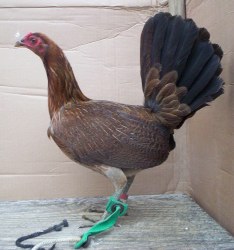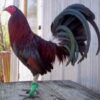Dark Hatch Fowl
$300.00 – $1,200.00
Appearance: Regular
Agility: 5/10
Type: Offensive Hen
Records: Crosses to Produce Perfect Fierce Kelso Chicks.
Fight Score: NO FIGHTS
The Dark Hatch Fowl
A Look into a Legendary Bloodline
The Dark Hatch Fowl is one of the most revered and widely recognized game fowl bloodlines among breeders and enthusiasts of American game fowl. Known for their striking appearance, formidable strength, and fighting prowess, Dark Hatch birds have earned a legendary status in the world of traditional game fowl breeding.
Origins of the Hatch Bloodline
The Hatch bloodline traces back to Sanford Hatch, a prominent figure in the early 20th-century American game fowl community. Hatch selectively bred his birds to emphasize not only physical power but also gameness—a term used by breeders to denote a bird’s willingness to continue fighting despite adversity.
Over the years, the Hatch line branched into various strains, each with slight variations in color, temperament, and fighting style. Among these, the Dark Hatch emerged as a distinctive and highly sought-after variant.
Characteristics of the Dark Hatch
What sets the Dark Hatch Stag apart from other game fowl are its unique physical and behavioral traits:
-
Appearance: Typically, Dark Hatch fowl (young roosters) feature dark green or black plumage with hints of red and mahogany. Their legs are often yellow or green, and their eyes are sharp and intense.
-
Stature: They are medium to heavy in build, with strong legs and broad chests, reflecting their power and endurance.
-
Temperament: These birds are known for their aggressive nature and high levels of confidence. Even at a young age, Dark Hatch fowl often display boldness and dominance.
-
Fighting Style: Traditionally praised for their ability to both cut and take punishment, Dark Hatches are considered “power hitters.” They typically fight with strength and pressure, often wearing down opponents over time.
Breeding and Legacy
The Dark Hatch is often crossed with other bloodlines such as Kelso, Roundhead, or Sweater to balance traits like speed, cutting ability, and gameness. These crosses aim to create a more versatile bird capable of adapting to different fighting styles and conditions.
Many breeders maintain that the pure Dark Hatch line is one of the hardest to come by, making it especially valuable in breeding circles. While the pure strain may be rare, its genetics have influenced countless hybrid lines used in both legal exhibitions and illicit arenas.
A Note on Ethics
It’s important to acknowledge that cockfighting is illegal in many parts of the world due to animal welfare concerns. The legacy of birds like the Dark Hatch fowl is therefore increasingly preserved through legal breeding, showing, and historical interest, rather than combat.
Conclusion
The Dark Hatch fowl stands as a symbol of heritage, breeding skill, and the complex legacy of game fowl in American rural culture. Whether viewed as a relic of a bygone tradition or as a living genetic masterpiece, the Dark Hatch remains a key figure in the rich tapestry of game fowl history.
| Select Fowl | Pairs, Pullets, Stags, Trio |
|---|---|
| Gender | Female, Male |
Be the first to review “Dark Hatch Fowl” Cancel reply
Related products
GAME FOWLS FOR SALE
GAME FOWLS FOR SALE
GAME FOWLS FOR SALE
GAME FOWLS FOR SALE
GAME FOWLS FOR SALE
Fighting Roosters
GAME FOWLS FOR SALE
GAME FOWLS FOR SALE













Reviews
There are no reviews yet.